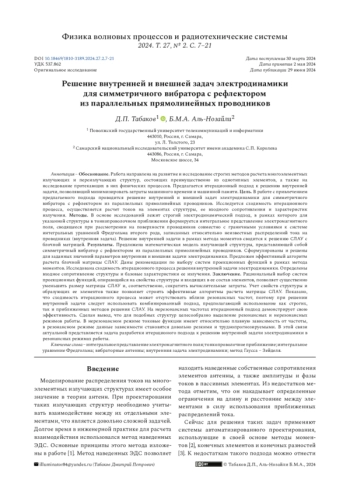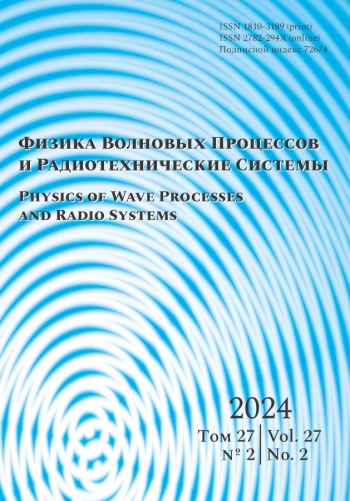Обоснование. Работа направлена на развитие и исследование строгих методов расчета многоэлементных излучающих и переизлучающих структур, состоящих преимущественно из однотипных элементов, а также на исследование протекающих в них физических процессов. Предлагается итерационный подход к решению внутренней задачи, позволяющий минимизировать затраты машинного времени и машинной памяти.
Цель. В работе с привлечением предлагаемого подхода проводится решение внутренней и внешней задач электродинамики для симметричного вибратора с рефлектором из параллельных прямолинейных проводников. Исследуется сходимость итерационного процесса, осуществляется расчет токов на элементах структуры, ее входного сопротивления и характеристик излучения.
Методы. В основе исследований лежит строгий электродинамический подход, в рамках которого для указанной структуры в тонкопроволочном приближении формируется интегральное представление электромагнитного поля, сводящееся при рассмотрении на поверхности проводников совместно с граничными условиями к системе интегральных уравнений Фредгольма второго рода, записанных относительно неизвестных распределений тока на проводниках (внутренняя задача). Решение внутренней задачи в рамках метода моментов сводится к решению СЛАУ с блочной матрицей.
Результаты. Предложена математическая модель излучающей структуры, представляющей собой симметричный вибратор с рефлектором из параллельных прямолинейных проводников. Сформулированы и решены для заданных значений параметров внутренняя и внешняя задачи электродинамики. Предложен эффективный алгоритм расчета блочной матрицы СЛАУ. Даны рекомендации по выбору систем проекционных функций в рамках метода моментов. Исследована сходимость итерационного процесса решения внутренней задачи электродинамики. Определены входное сопротивление структуры и базовые характеристики ее излучения.
Заключение. Рациональный выбор систем проекционных функций, опирающийся на свойства структуры и входящих в ее состав элементов, позволяет существенно уменьшить размер матрицы СЛАУ и, соответственно, сократить вычислительные затраты. Учет свойств структуры и образующих ее элементов также позволяет строить эффективные алгоритмы расчета матрицы СЛАУ. Показано, что сходимость итерационного процесса может отсутствовать вблизи резонансных частот, поэтому при решении внутренней задачи следует использовать комбинированный подход, предполагающий использование как строгих, так и приближенных методов решения СЛАУ. На нерезонансных частотах итерационный подход демонстрирует свою эффективность. Сделан вывод, что для подобных структур целесообразно выделение резонансных и нерезонансных режимов работы. В нерезонансном режиме токовые функции имеют относительно плавную зависимость от частоты, в резонансном режиме данные зависимости становятся довольно резкими и труднопрогнозируемыми. В этой связи актуальной представляется задача разработки итерационого подхода к решению внутренней задачи электродинамики в резонансных режимах работы.
Background. The work is aimed at the development and research of rigorous methods for calculating multi-element emitting and re-emitting structures, consisting mainly of the same type of elements, as well as studying the physical processes occurring in them. An iterative approach to solving the internal problem is proposed, which allows minimizing the cost of computer time and computer memory.
Aim. In this work, using the proposed approach, we solve the internal and external problems of electrodynamics for a symmetrical vibrator with a reflector made of parallel straight conductors. The convergence of the iterative process is studied, the currents on the elements of the structure, its input resistance and radiation characteristics are calculated.
Methods. The research is based on a strict electrodynamic approach, within the framework of which, for the specified structure in the thin-wire approximation, an integral representation of the electromagnetic field is formed, which, when considered on the surface of conductors together with boundary conditions, is reduced to a system of Fredholm integral equations of the second kind, written relative to unknown current distributions on conductors (internal task). The solution of the internal problem within the framework of the method of moments is reduced to solving a SLAE with a block matrix.
Results. A mathematical model of a radiating structure is proposed, which is a symmetrical vibrator with a reflector made of parallel straight conductors. The internal and external problems of electrodynamics are formulated and solved for given parameter values. An effective algorithm for calculating the block matrix of SLAEs is proposed. Recommendations are given for the selection of systems of projection functions within the framework of the method of moments. The convergence of the iterative process for solving an internal problem of electrodynamics has been studied. The input resistance of the structure and the basic characteristics of its radiation are determined.
Conclusion. A rational choice of systems of projection functions, based on the properties of the structure and its constituent elements, makes it possible to significantly reduce the size of the SLAE matrix and, accordingly, reduce computational costs. Taking into account the properties of the structure and its constituent elements also makes it possible to construct effective algorithms for calculating the SLAE matrix. It is shown that the convergence of the iterative process may be absent near resonant frequencies, therefore, when solving the internal problem, a combined approach should be used, which involves the use of both rigorous and approximate methods for solving SLAEs. At non-resonant frequencies, the iterative approach demonstrates its effectiveness. It is concluded that for such structures it is advisable to distinguish between resonant and non-resonant operating modes. In the non-resonant mode, the current functions have a fairly smooth dependence on frequency; in the resonant mode, these dependences become quite sharp and difficult to predict. In this regard, the task of developing an iterative approach to solving the internal problem of electrodynamics in resonant operating modes seems relevant.
Идентификаторы и классификаторы
- Префикс DOI
- 10.18469/1810-3189.2024.27.2.7-21
- eLIBRARY ID
- 67945991











